|
Scratch built 1/32 scale
S.N.C.A.C. NC. 1070
by Frank Mitchell
|
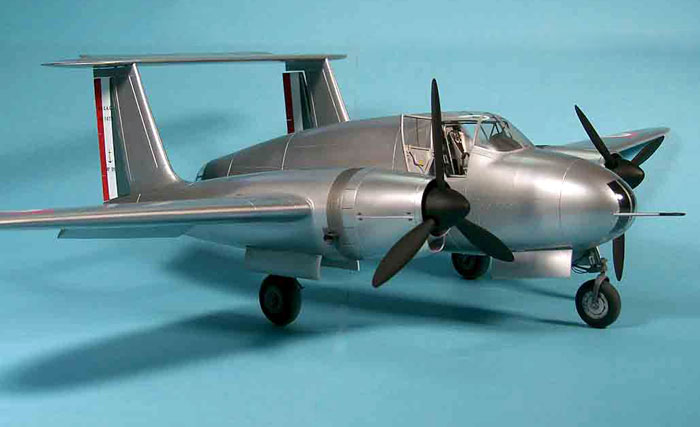 |
|
S.N.C.A.C. NC. 1070 |

HyperScale is
proudly supported by
Squadron
Whatever else one might say about the
French aircraft industry, it has to be conceded that in the period prior
to and following WWII, it was among the most innovative in the world.
While not all of the designs were commercially or militarily successful,
they did explore new ideas and different ways of doing things.
Unfortunately, many of the more original designs remain obscure, but for
a modeler who likes to tackle unusual subjects, they are a rich source
of ideas, and this aircraft is a typical example.
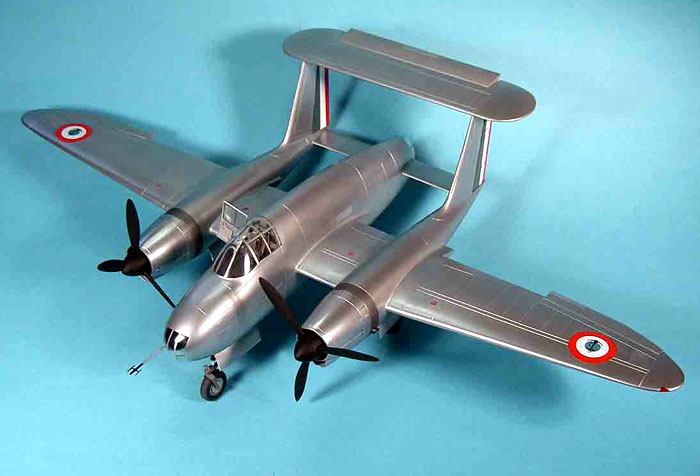
Since I assume that for most, this
aircraft definitely falls into the category of “obscure”, a short
history:
The S.N.C.A.C. NC. 1070 (hereinafter referred to as the “1070”) was
designed as a carrier-based, light Naval
attack/reconnaissance/antisubmarine/torpedo aircraft by the Societe
Nationale de Construction Aeronautiques du Centre (SNCAC). It was 33.5
feet in length, and its wings, designed to have a double-folding
arrangement, spanned nearly 66 feet. It was powered by two 1600
horsepower Gnome-Rhone radial engines which gave it a maximum speed of
360 mph. It was intended to have a crew of three, and an armament of
four 20mm cannon, with either a single torpedo or 1800 pounds of bombs
in an internal bomb bay. The first flight took place on 23 May, 1947,
and although subsequent flights were quite successful, it was decided
not to pursue any further propeller aircraft and to concentrate instead
on jet powered equipment. Perhaps the most important contribution of the
1070 was that it led to the NC. 1071, which was essentially the same
design carrying 2 Rolls-Royce Nene engines in two huge boom/nacelles.
That was one of France’s first jet aircraft and was also the first
French jet aircraft with a ejection seat.
As can be seen in the construction
photos, this model was built pretty much in my standard way, but with a
few modifications to adjust for its size (almost 25-inch wingspan) and
its awkwardness; it was difficult to get to or paint some surfaces if
other parts were assembled too soon. It was therefore built pretty much
inside-out, with the outer wings being the last pieces to be attached.
The fuselage, horizontal tail, one vertical tail, and one boom
(including the cowling) were carved from balsa, smoothed and prepped,
then vacuum-formed, with two copies being made of the booms and the
vertical tail surfaces. The booms and fins were then built up with
formers, while the fuselage retained as much wood as possible for
purposes of strength. An assembly board/jig was used throughout
construction since there was no way that everything could be aligned
properly without one.
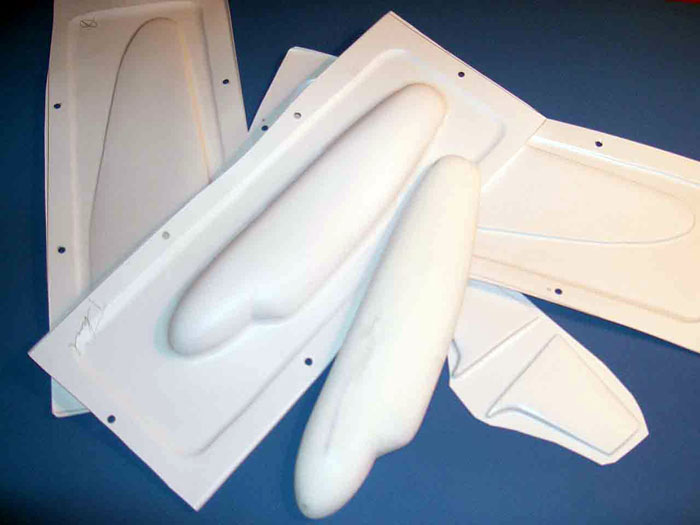
Click the
thumbnails below to view larger images:
[../../photogallery/photo00019065/real.htm]
After fitting the fuselage skins to the
balsa core, the cockpit portion was removed and used as a mold for the
canopy. The entire nose and tail areas were also replaced so that when
the actual clear areas were masked off, there would be no problems with
visible seams. The landing gear were made from brass and aluminum tubing
and the wheels were molded in resin from an RTV mold of a turned wooden
master. The landing gear is also an example of one of the problems of
building little-known prototype aircraft. Even if one can find
information, the few pictures that are usually found will invariably
show significant differences due to changes made during testing. In this
case, most pictures show the main gear as having two major struts on
each leg, but in a couple of the pictures, there is only one. Decisions
have to be made.
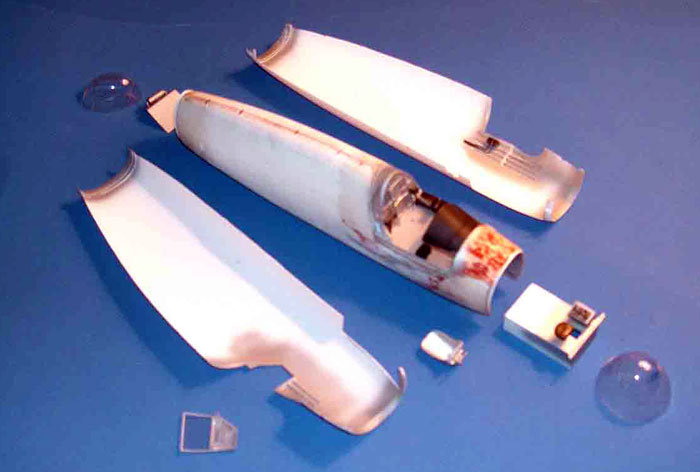
The wing was formed in two halves since it was too long for my
vacuum-forming machine. The wing skins were epoxied to the balsa core
after the halves had been reassembled using a couple of short brass
tubing spars. After the leading trailing edges were finished, the outer
wings were cut from the center section. The flaps were cut away from the
wings and center section and re-fitted to the trailing edges in the down
position. The other control surfaces were also removed and replaced
using brass wire.
The cowlings were cut from the booms and the lower intake scoops were
formed over balsa molds. The cowl flaps were scribed and slits were cut
between each small flap. Propeller blades were carved from balsa,
covered with thin superglue, and sanded and primed. The blades were
attached inside the spinners to a small roughly turned block of wood.
The spinners themselves were molded from basswood patterns turned on a
small lathe. A small jig was made to align the blades correctly.
Exhausts were piece of aluminum tubing glued through holes in the boom.
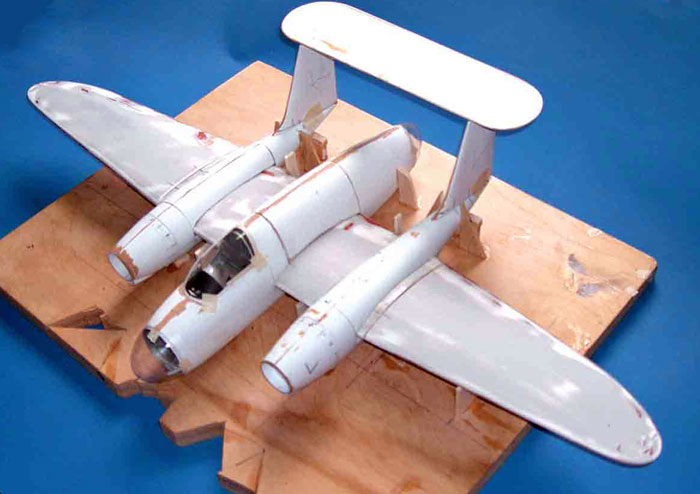
A considerable amount of lead had to be added to the nose and both
engines because of the short fuselage combined with the extensive tail
surfaces. This thing is heavy.
Filling, sanding, and scribing were done throughout the build, since
many areas would be hard to reach later, and it was only when as much
was done as possible that the outer wings were attached.
The finish is Alclad II sprayed over the automotive lacquer primer
that was used throughout. It was lightly polished with SNJ powder and
panels applied using Gunze, Alclad, and even some Floquil paints.
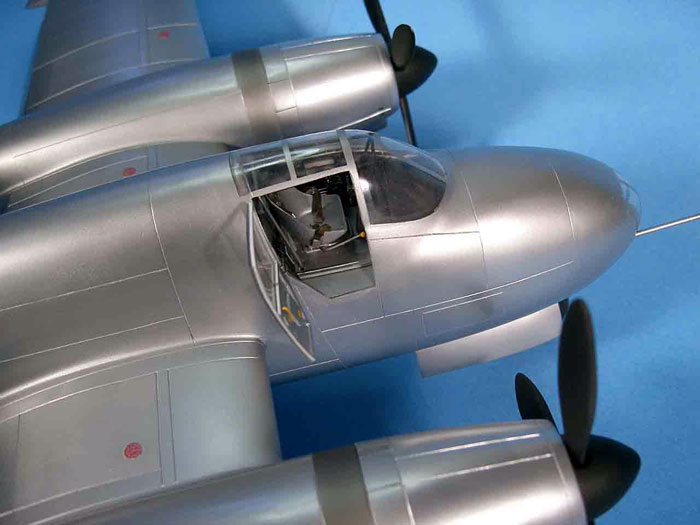
The roundels came from the new 1/48th kit of the Loire 130, which
saved me having to do roundels with anchors in them.
The small lettering on the tail was done on the computer and printed
on decal film with a laser printer.
I have to admit that I was not terribly sad to finish this model; it
was very awkward and just plain big, which, towards the end, made it a
bit of a battle.
It certainly falls into a favorite area of mine (strange and
obscure), but I don’t think I will do another one any time soon.
Click the
thumbnails below to view larger images:
[../../photogallery/photo00012930/real.htm]
Model, Images and Text Copyright © 2007
by Frank Mitchell
Page Created 28 November, 2007
Last Updated
24 December, 2007
Back to
HyperScale Main Page |
Home
| What's New |
Features |
Gallery |
Reviews |
Reference |
Forum |